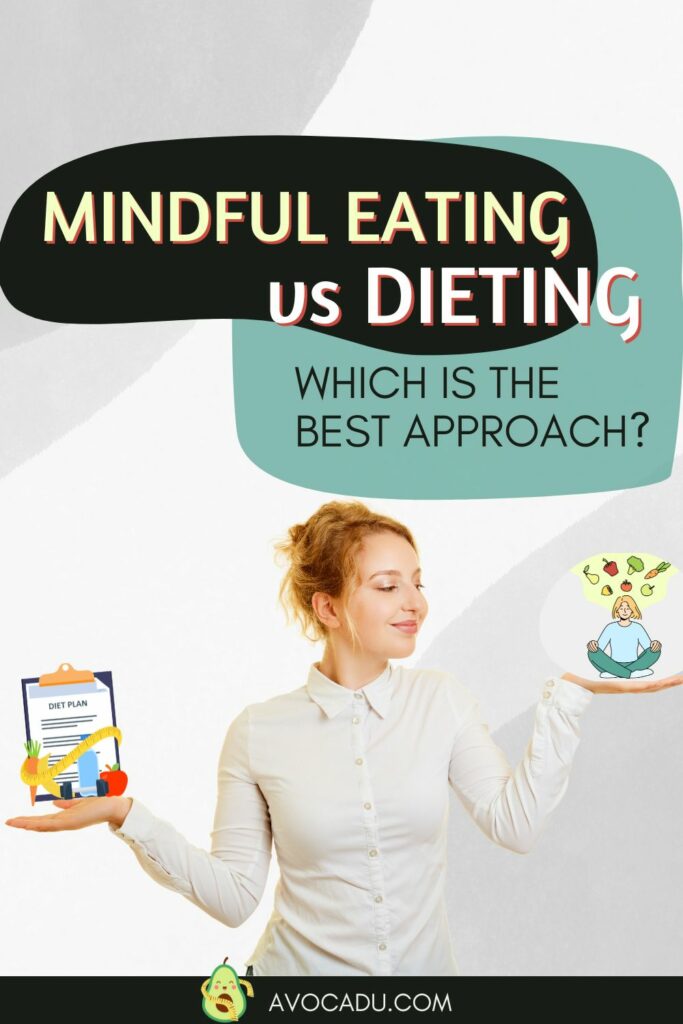Mindful Eating vs Dieting: Which is More Effective for Weight Management?
Ever wondered if there’s a better way to manage your weight than constantly hopping on the latest diet trend? You’re not alone.
Many people are finding themselves frustrated with the cycle of starting a new diet, seeing some initial success, and then watching the pounds creep back on.
The debate between mindful eating vs dieting has gained traction, and for good reason.
With mindful eating focusing on a holistic and intuitive approach to food, and traditional dieting emphasizing structured plans and restrictions, there’s a lot to consider.
Let’s break down these two approaches and see which might be the key to long-term weight management and sustainable lifestyle changes.
Related article: A Comprehensive Guide to Mindful Eating: Benefits, Techniques, and More

This post may contain affiliate links, which helps keep this content free. Please read our disclosure for more info.
What is Traditional Dieting?
Traditional dieting is something most of us are familiar with. It involves following specific rules about what and how much to eat, often with the goal of losing weight quickly. These diets typically come with a set of external guidelines that dictate your food choices, portions, and eating schedules.
For example, calorie counting is a common method where you track every morsel of food to stay within a daily limit. This approach aims to create a calorie deficit, which should theoretically lead to weight loss.
Meal plans are another popular dieting method. These involve following a pre-determined menu that specifies what you should eat for each meal and snack. This can take the guesswork out of dieting but can also feel restrictive and monotonous over time. Jenny Craig offers pre-packaged meals and personal coaching to help you stick to your diet plan.
Many traditional diets also involve cutting out entire food groups. For instance, low-carb diets like keto eliminate most carbohydrates, focusing instead on fats and proteins to trigger a state of ketosis, where the body burns fat for fuel.
Similarly, paleo diets exclude grains, legumes, and dairy, emphasizing whole foods that our ancestors might have eaten.
Intermittent fasting is another trend that has gained popularity. This diet involves cycling between periods of eating and fasting, such as the 16/8 method, where you eat during an 8-hour window and fast for the remaining 16 hours of the day.
Other traditional diets include programs like Weight Watchers, now known as WW, which uses a points system to encourage healthier eating habits without strict calorie counting.
The Mediterranean diet focuses on consuming healthy fats, lean proteins, and plenty of fruits and vegetables, inspired by the traditional eating habits of countries bordering the Mediterranean Sea.
On the more extreme end, there are fad diets that promise quick results but often at the cost of nutritional balance and long-term sustainability.

- The cabbage soup diet is a short-term weight loss diet that involves consuming large quantities of cabbage soup.
- The grapefruit diet claims that eating grapefruit with every meal can help burn fat.
- Juice cleanses involve consuming only fruit and vegetable juices for several days to detoxify the body and lose weight quickly.
- The master cleanse, popularized by celebrities, consists of a lemon juice, maple syrup, and cayenne pepper concoction intended to flush out toxins and shed pounds rapidly.
These traditional and fad diets share a common goal of helping you shed pounds through various forms of restriction and structured eating.
While they can be effective in the short term, the rigid nature of these diets can make them challenging to maintain over the long haul, often leading to a cycle of losing and regaining weight.
The Basics of Mindful Eating
Mindful eating takes a different approach compared to traditional dieting. Instead of following strict rules or external guidelines, mindful eating focuses on tuning into your body’s natural hunger and fullness cues and paying close attention to the experience of eating. The goal is to foster a healthy relationship with food, free from guilt and restriction.
Listening to Your Body
One of the core principles of mindful eating is learning to listen to your body. This means recognizing when you’re genuinely hungry and when you’re full. It encourages you to eat when you’re hungry and stop when you’re satisfied, rather than eating out of boredom, stress, or habit.
This approach helps you become more in tune with your body’s needs and prevents overeating.
Eating with Awareness
Mindful eating involves paying full attention to the act of eating. This means being present and engaging all your senses while you eat.
Notice the colors, textures, and aromas of your food. Take the time to savor each bite, appreciating the flavors and the effort that went into preparing the meal.
Eating with awareness can transform mealtime into a more enjoyable and satisfying experience.
Distinguishing Between Physical Hunger and Emotional Eating
Understanding the difference between physical hunger and emotional eating is another key aspect of mindful eating. Physical hunger is your body’s way of signaling that it needs nourishment, whereas emotional eating is often a response to feelings like stress, boredom, or sadness.
By becoming aware of these triggers, you can learn to address your emotional needs in healthier ways, rather than turning to food for comfort.
Eating Without Guilt
Mindful eating encourages you to let go of the guilt often associated with eating. Instead of labeling foods as “good” or “bad,” it promotes a more balanced and flexible approach to eating.
This means allowing yourself to enjoy your favorite treats in moderation without feeling guilty. This shift in mindset can help break the cycle of restrictive dieting and binge eating, leading to a more positive relationship with food.
Savoring Your Food

Taking the time to savor your food is a fundamental part of mindful eating. This means slowing down and truly enjoying each bite, which can enhance your overall eating experience.
Savoring your food helps you feel more satisfied and can prevent overeating, as you’re more likely to recognize when you’re full.
Being in the Moment
Mindful eating also involves being fully present during meals. This means minimizing distractions, such as turning off the TV or putting away your phone, so you can focus on the act of eating.
Being in the moment allows you to enjoy your food more and helps you become more aware of your eating habits.
Mindful Practices
Incorporating mindful practices into your daily routine can enhance your mindful eating journey.
Techniques such as body scan meditation, where you focus on the physical sensations in your body, or keeping a mindful food journal, where you record your eating experiences and feelings, can help you stay connected to your body’s needs and your emotional state.
Mindful eating is not about perfection or strict adherence to a set of rules. It’s about cultivating a more conscious and compassionate relationship with food, which can lead to long-term benefits for both your physical and mental health.
By embracing these principles, you can find a more sustainable and enjoyable path to weight management.
Comparing the Two Approaches
So, how do these approaches stack up against each other?

Methodology Differences
Dieting focuses on restriction and following external rules. This can mean cutting calories, avoiding certain foods, or eating at specific times. It’s a regimented approach that can sometimes feel rigid and unforgiving.
Mindful eating, however, is about turning inwards. It encourages you to trust your body’s signals and make choices based on how you feel, rather than what a diet plan dictates. There’s no “one size fits all” rule; it’s about finding what works for you.
Impact on Mental and Emotional Health
Dieting can often lead to stress, food obsession, and a negative relationship with food. The constant cycle of restriction and bingeing can take a toll on your mental health, leading to feelings of guilt and frustration.
In contrast, mindful eating promotes a healthier relationship with food. By removing the guilt associated with eating and focusing on the pleasure and satisfaction food can bring, it helps reduce stress and emotional eating.
Long-Term Results
One of the biggest drawbacks of traditional dieting is its sustainability. Many people find themselves trapped in a cycle of yo-yo dieting, where they lose weight only to gain it back again. This can be disheartening and make long-term weight management seem impossible.
Mindful eating, however, encourages sustainable habits. By fostering a positive relationship with food and teaching you to listen to your body, it supports long-term weight management. It’s not about quick fixes but about making lasting changes.
Making the Switch to Mindful Eating
Interested in giving mindful eating a try? Here are some practical tips to help you get started on this journey towards a healthier relationship with food and more sustainable weight management.
Start Small
Begin with small, manageable changes that can gradually become part of your routine. For instance, start by eating without distractions.

Turn off the TV, put away your phone, and create a calm environment where you can focus solely on your meal.
Pay attention to the flavors, textures, and aromas of your food. Another small change is to take the time to savor your meals.
Chew slowly, and allow yourself to fully enjoy each bite. These simple adjustments can make a big difference in how you experience food and recognize your body’s hunger and fullness cues.
Be Patient
Transitioning to mindful eating takes time and patience. It’s important to remember that change won’t happen overnight. Be kind to yourself and practice self-compassion throughout this process.
There may be moments when you revert to old habits, and that’s okay. Instead of feeling discouraged, acknowledge these slip-ups and view them as learning opportunities. Patience and persistence are key to making mindful eating a lasting part of your life.
Mindful Practices
Incorporating mindful practices into your daily routine can enhance your mindful eating journey. Here are a few techniques to consider:
- Body Scan Meditation: This involves focusing on different parts of your body and noticing any sensations, tension, or discomfort. It can help you become more aware of how your body feels and what it needs. Practicing a body scan before meals can ground you and bring your attention to the present moment, making it easier to eat mindfully.
- Mindful Food Journal: Keeping a journal of your eating experiences can be incredibly insightful. Record not only what you eat, but also how you feel before, during, and after your meals. Note any patterns or triggers that lead to emotional eating. This practice can help you identify areas where you might need more attention and develop a deeper understanding of your relationship with food.
- Mindful Breathing: Before you start eating, take a few deep breaths to center yourself. This can help you shift your focus from any external distractions to the meal in front of you. Mindful breathing can also reduce stress, making it easier to listen to your body’s hunger and fullness cues.
- Gratitude Practice: Take a moment before your meal to express gratitude for the food you’re about to eat. Reflect on the effort that went into preparing the meal and the nourishment it will provide. This practice can foster a positive mindset and enhance your overall eating experience.
Mindful Eating Exercises
Engaging in specific mindful eating exercises can further support your transition. Here are a couple to try:
- The Raisin Exercise: This is a classic mindful eating exercise where you eat a single raisin with full attention. Hold the raisin, observe its texture and color, smell it, and finally, place it in your mouth, noticing the taste and texture as you chew slowly. This exercise helps you practice being fully present and can be applied to any food.
- Hunger and Fullness Scale: Use a scale from 1 to 10 to gauge your hunger and fullness levels, with 1 being extremely hungry and 10 being uncomfortably full. Check in with yourself before, during, and after meals to better understand your body’s signals. Aim to eat when you’re at a 3 or 4 (moderately hungry) and stop when you’re at a 6 or 7 (comfortably satisfied).
Mindful Eating Environment
Create an environment that supports mindful eating. This might involve setting a pleasant table, playing calming music, or dining with people who support your mindful eating practices.
Avoid eating in front of screens or in a rushed manner, as these habits can detract from your ability to eat mindfully.
Consistency and Routine
Establishing a consistent eating routine can also aid in your mindful eating practice. Try to eat at regular times each day and avoid skipping meals, which can lead to overeating later. A regular routine helps your body establish a rhythm and makes it easier to tune into your hunger and fullness cues.
Making the switch to mindful eating is a gradual process that requires practice and patience. By starting small, incorporating mindful practices, and creating a supportive environment, you can cultivate a healthier relationship with food and enjoy the benefits of sustainable weight management..
Finding Your Path to Sustainable Weight Management
When it comes to weight management, there’s no one-size-fits-all solution. However, mindful eating offers a refreshing alternative to traditional dieting.
By fostering a positive relationship with food and focusing on sustainable habits, it provides a pathway to long-term health and well-being. If you’re tired of the diet cycle, why not give mindful eating a try? It might just be the change you’ve been looking for.
For those seeking a structured start, consider trying the 21-Day Fat Loss Challenge. This program falls under the traditional diet approach, providing a clear plan to kickstart your weight loss journey. It offers a disciplined framework that can help you see quick results.

However, long-term success often requires a shift towards more sustainable habits. That’s why we encourage challengers to follow up the initial 21 days with the After the Challenge program.

This program focuses on lifestyle changes that promote lasting health and well-being, integrating the principles of mindful eating and sustainable living.
By combining the initial structure of the 21-Day Fat Loss Challenge with the sustainable practices taught in After the Challenge, you can create a balanced approach to weight management that works for you in the long run.

